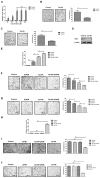Tanshinone IIA induces apoptosis of ovarian cancer cells in vitro and in vivo through attenuation of PI3K/AKT/JNK signaling pathways
- PMID: 30675253
- PMCID: PMC6341594
- DOI: 10.3892/ol.2018.9744
Tanshinone IIA induces apoptosis of ovarian cancer cells in vitro and in vivo through attenuation of PI3K/AKT/JNK signaling pathways
Abstract
Ovarian cancer is one of the most common gynecological tumors and is the second most common cause of gynecological cancer-associated mortality worldwide. Tanshinone IIA (Tan-IIA) possesses anticancer activities through inducing the apoptosis of tumor cells. The purpose of the present study was to analyze the ability of Tan-IIA to induce apoptosis of human ovarian cancer cells in vitro and in vivo, and to examine the potential mechanism underlying its activity. Western blot analysis, immunohistochemistry and flow cytometry were used to analyze the therapeutic effects of Tan-IIA on ovarian cancer. It was demonstrated that Tan-IIA significantly inhibited the growth and aggressiveness of human ovarian cancer cells. Tan-IIA significantly increased the apoptosis of human ovarian cancer cells through cleavage activation of caspases-3, caspase-8 and caspases-9. In addition, Tan-IIA treatment decreased the expression of mitochondrial-protective B-cell lymphoma 2-like protein 2 (Bcl-w) and myeloid cell leukemia-1 long (Mcl-1L) in ovarian cancer cells. Tan-IIA also reduced the expression of phosphoinositide 3-kinase (PI3K), AKT and c-Jun N-terminal kinase (JNK) in human ovarian cancer cells. A specific PI3K inhibitor (LY294002) enhanced the Tan-IIA-inhibited expression of AKT and JNK. The overexpression of PI3K negated the Tan-IIA-inhibited expression of AKT and JNK, and eliminated the Tan-IIA-induced apoptosis of human ovarian cancer cells. Additionally, the in vivo assay showed that Tan-IIA treatment inhibited the growth of ovarian cancer through increasing the apoptosis of tumor cells. In conclusion, these findings suggested that the induction of apoptosis by Tan-IIA involves the PI3K/AKT/JNK signaling pathways in ovarian cancer.
Keywords: apoptosis; ovarian cancer; phosphoinositide 3-kinase/AKT/c-Jun N-terminal kinase; tanshinone IIA.
Figures




References
-
- Khoja L, Nolan K, Mekki R, Milani A, Mescallado N, Ashcroft L, Hasan J, Edmondson R, Winter-Roach B, Kitchener HC, et al. Improved survival from ovarian cancer in patients treated in phase III trial active cancer centres in the UK. Clin Oncol (R Coll Radiol) 2016;28:760–765. doi: 10.1016/j.clon.2016.06.011. - DOI - PubMed
-
- Edwards HM, Noer MC, Sperling CD, Nguyen-Nielsen M, Lundvall L, Christensen IJ, Høgdall C. Survival of ovarian cancer patients in Denmark: Results from the Danish gynaecological cancer group (DGCG) database, 1995–2012. Acta Oncol. 2016;55(Suppl 2):S36–S43. doi: 10.1080/0284186X.2016.1182641. - DOI - PubMed
LinkOut - more resources
Full Text Sources
Other Literature Sources
Research Materials
Miscellaneous
